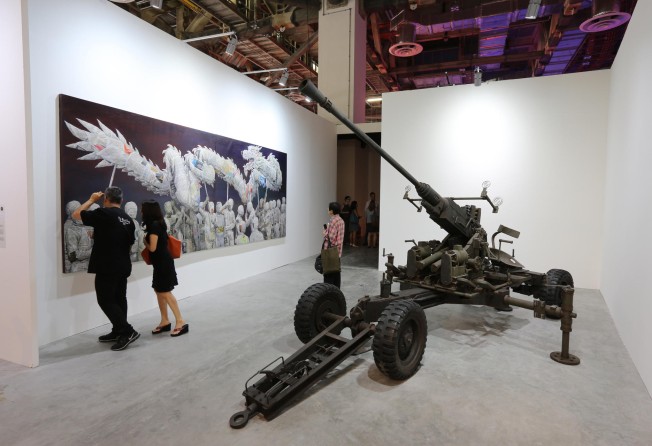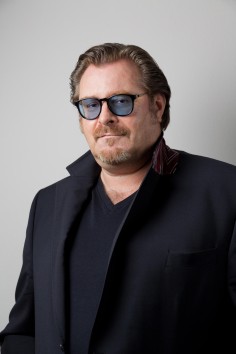Art Stage Singapore puts region's art in global spotlight
Art Stage Singapore is helping to put the region's artists in the global spotlight, writes Clara Chow

Ask Art Stage Singapore's Lorenzo Rudolf how the contemporary art fair he founded, co-owns and directs has managed to stay in the game, despite competition in the region, and he'll reply with a mischievous answer: who are these rivals that people speak of? "I don't see so many players," he retorts.
One could, of course, reel off names such as the India Art Fair in New Delhi, the Affordable Art Fair in Singapore, SH Contemporary in Shanghai and Art Basel Hong Kong, to name but a few.
Smiling at the mention of Art Basel - Rudolf, a former director, is credited with transforming that modest event into a glitzy Miami Beach-style success - he says: "Competition is the best thing for the business. There are only two places where you can make an international art fair in Asia: Hong Kong and Singapore. It's the best thing that can happen for Asia - the biggest continent in the world and two fairs.
"Count all the fairs in Europe - it's 10 times more. Asia is a continent that's growing, increasing, which means they need platforms like that, a successful top fair in Hong Kong and Singapore, as long as the two fairs are not at the same time and do not have the same concept," the 54-year-old Swiss says, adding he is happy that his old colleagues from Art Basel have ventured to Asia.

"It's not a question of an increase, but a question of what you want," says the fair director. "It is typical of every contemporary art fair to try to balance both sides: not just a fair for billionaires, but also quality works, young art that [is] not expensive. The importance is to have the entire balance."
This year's event, from January 16 to 19, also aims to strike a balance between the business of selling art, and that of educating collectors. To that end, a new format will be introduced at its fourth instalment, with eight curated country and regional platforms taking up 2,000 square metres - or 20 per cent of total floor space at the fair - to be held at Marina Bay Sands Expo and Convention Centre. Dedicated to art from places such as Southeast Asia, India, China, Taiwan, Japan, South Korea, Australia and Central Asia, these will be "museum-like" showcases, put together by the likes of Mami Kataoka, chief curator at Mori Art Museum in Tokyo, and independent Chinese curator Huang Du.
"Every artist presented in this exhibition is backed by a gallery, but not in the form that they have a booth. They are integrated into an exhibition where everything is for sale," says Rudolf.
Last year, he drew flak over the fair's independently curated Indonesian pavilion as Singapore artists questioned why their government-supported event was championing foreign artists over them. Among the projects for this year's platforms is an on-site installation-cum-performance, titled I ntermission on Stage, by Myanmese artist Soe Naing.
Rudolf says that for the duration of the art fair, Soe Naing will be ensconced in a large shipping container-sized "cottage", where he will be producing his art - an extension of his daily drawing and visual journal-keeping. "Soe Naing plays, in a certain way, with his past as an artist and the past of Myanmar as a country occupied by a military regime, producing art in a clandestine way for himself."
Soe Naing, 52, is curious to discover how he will be affected by this exposure as part of the Southeast Asian platform at Art Stage. "I usually work in isolation," he says. "I wanted to know how I would paint differently when I am being watched, and that is why I am doing the installation - as an experiment. But the lack of privacy is a major concern."
Also being presented at the fair's Chinese platform is Chengdu-based artist Chen Quilin's intriguing works made out of tofu. The avant-garde artist will riff on her Tofu-100 Chinese Surnames series, comprising characters of common Chinese surnames made from the basic beancurd staple in Han Chinese diets.
Chen, 38, writes in an e-mail interview that the work explores "how the transmission of culture and its meanings are impacted on" today's world. "What I hope to get out of being in Art Stage is to present my work in front of an audience that once shared a common history with us," she adds, referring to Singapore's ethnic Chinese population.
In a way, it is precisely Rudolf's combination of smooth, diplomatic persuasiveness, and his ability to change and improvise, that has kept Art Stage as a premier art fair in the region, and very possibly the most high profile in Southeast Asia.
As French collector Sylvain Levy, an Art Stage regular, puts it: "Art Stage is unique because it is mostly an Asian fair, specially dedicated to South Asian art. It is very well organised. It also gives us the opportunity to meet our friends from South Asia and Australia."
Rudolf says: "On the one side, you have to have a clear strategy. You need a certain block [of exhibitors and selections] that is congruent. On the other side, you have to, year on year, do some changes."
From his experience in organising art fairs, he says there's a change of 25 to 30 per cent of galleries from year to year: "Art Stage is the only real fair in Asia with a real Asian identity. We are not a fair that wants to copy a western fair. People need to see the strengths of Asia."
Citing the contrast between the brash commercialism at Art Basel Miami, and the esoteric aesthetic of the Venice Biennale, the fair director makes a case for bridging the two extremes in order to create a sustainable market.
"If you decide to do an art fair in Asia, it means you're dealing with young markets. You have to educate, you have to introduce art," he says. "You also have to be aware that you're doing a fair in a continent that's totally segmented.
"It's not like when you go to New York, and you see what's happening in America. Here, they are closed markets. If you say, 'Give me an expert in China about Indonesian art', I cannot [find one for you]. We are in the situation about increasing new markets, many new markets."